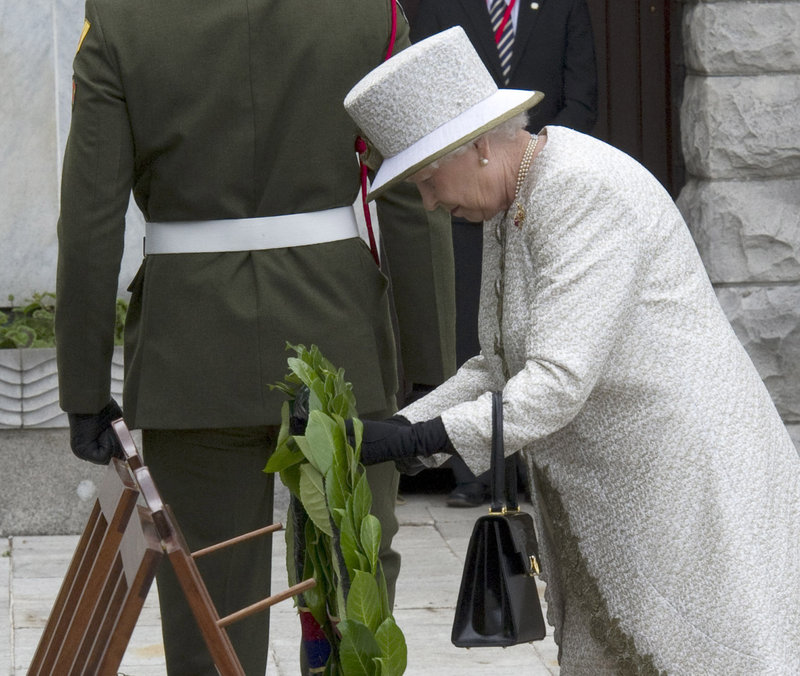LONDON — The last time a British monarch set foot in the south of Ireland, the Emerald Isle was still a jewel in his crown and its people were still his subjects. The king was George V, and his visit took place a century ago.
On Tuesday, his granddaughter, Queen Elizabeth II, became the first of his successors to follow in his footsteps — only this time she came as the head of state of a foreign country, on an official visit to a proudly independent republic.
Her historic four-day trip is testament to the new reality of Anglo-Irish relations, a seal on the reconciliation of two nations bound by a complicated and bloody past. For decades after Ireland gained its independence from Britain in 1922, bitterness marred the relationship across the Irish Sea.
But ties between the two countries, each other’s closest neighbor, have matured and warmed enough for them to treat each other as equals. That, and the success of peacemaking in Northern Ireland, paved the way for a royal visit that would have been anathema not long ago to the many Irish whose ancestors suffered under Elizabeth’s.
“Generations of Irish patriots could only dream of a time when a British monarch would arrive here as honored guest rather than condescending ruler, as a friendly neighbor rather than an embodiment of imperial power,” the Irish Times marveled in an editorial published Tuesday, adding: “It is at last possible to say that the relationship between Britain and Ireland is simply normal.”
The queen’s plane touched down at a military airbase near Dublin named after Roger Casement, an ardent nationalist whom the British government executed for treason in 1916.
Wearing a shamrock-green coat and hat, the 85-year-old monarch was driven in a bulletproof car to Irish President Mary McAleese’s official residence, an imposing white building once home to the viceroys who administered Ireland on behalf of the British crown.
It was McAleese who issued the invitation for a state visit; the two women have met several times previously.
Before the queen’s arrival, McAleese called it “absolutely the right moment” for such a visit. In London, British Prime Minister David Cameron said: “Now is a great moment for people in Britain and people in Ireland to remember what it is we share.”
Polls showed a majority of Irish to be in support of the visit, but dozens of people protested nearby when the queen made a powerfully symbolic stop at a garden dedicated to the memory of those who died in the struggle for Ireland’s freedom from often harsh and repressive British rule.
She laid a wreath in solemn tribute while an Irish military band struck up “God Save the Queen.”
Though the visit was announced last year, the groundwork was laid in 1998, when republicans and loyalists signed the power-sharing pact that formally ended armed hostilities in Ireland agreed to drop its claim to the territory.
According to The Associated Press, police scuffled with small groups of anti-British protesters at two spots on the edge of the security perimeter. Many waved placards that read “Britain out of Ireland,” referring to the fact that Northern Ireland remains part of the United Kingdom.
At one flashpoint involving about 50 protesters, officers used pepper spray to prevent a few men from breaching security barriers, then police on horseback drove back the crowd.
At the other trouble spot, protesters tried to block Dublin’s major thoroughfare, O’Connell Street, but were pushed to the sidewalk by police. No injuries were reported.
The protesters were outnumbered by several thousand well-wishers hoping to get a glimpse of the queen and her husband, Prince Philip.
Send questions/comments to the editors.



Success. Please wait for the page to reload. If the page does not reload within 5 seconds, please refresh the page.
Enter your email and password to access comments.
Hi, to comment on stories you must . This profile is in addition to your subscription and website login.
Already have a commenting profile? .
Invalid username/password.
Please check your email to confirm and complete your registration.
Only subscribers are eligible to post comments. Please subscribe or login first for digital access. Here’s why.
Use the form below to reset your password. When you've submitted your account email, we will send an email with a reset code.